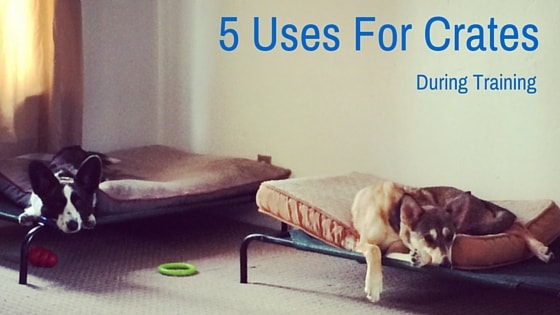
Many clients are averse to the idea of crating their dogs. Being able to explain to them how crating can help their dog’s training progress may open them up to the concept.
Housetraining
Crating can be of immense benefit when it comes to housetraining a dog, regardless of age. It keeps the dog confined to a relatively small space, keeping them from being able to roam and squat wherever they desire. Feeding the dog in the crate makes housetraining go even faster as most dogs will not go to the bathroom where they eat. Obviously it is important to stress to your clients the importance of taking the dog outside on a regular basis. Also, be sure to emphasize that crating is not to be utilized 24/7, but only when the dog is not able to be immediately supervised.
Settle
Crating can teach a dog that it’s okay to relax. Starting with very small amounts of time, clients can put their dogs in a crate with something yummy to chew on. Doing this consistently can teach the dog that good things happen in there and it’s okay to relax and settle down. This can be helpful at times when visitors are coming and going or the dog just needs to be out of the way for some reason. Having a dog that will settle in its crate can be a great management tool.
Home Base
Group classes are a great time to utilize crating. When you are talking and your attendees need to listen, they can put their dog (who knows that settling in a crate is a good thing!) in the crate so they can focus on you. The crate can also act as a home base for the dog when things get stressful or he just needs a break. Or make a training game of it – have your client do some work with the dog and then they and their dog can run to the crate together and throw a party when the dog enters.
Separation Distress/Anxiety
Separation distress/anxiety can be a nightmare to deal with, but crating can sometimes help ward it off. If your client’s dog has learned to associate the crate with Very Good Things, and has learned that its crate is used for settling in and relaxing, it can help the process of treating the separation anxiety. It is also useful to prevent a dog from pacing back and forth from window to window and barking at people/animals passing by, thereby keeping their stress levels elevated. Crating can encourage the dog to just relax and sleep or work on a chew toy. Note: Separation anxiety can be dangerous for the dog – if you are not confident in your ability to recommend a course of action that will keep the dog safe during training, please refer your client to somebody who is!
Preparation For Emergencies
Nobody ever wants a tragedy to occur, but sometimes they do. What happens if your client’s dog gets sick and has to spend the night at the e-vet? If the dog isn’t accustomed to crating, it can get incredibly stressed out, hindering treatment. If you and your clients live in a location with natural disasters that might prompt evacuation, having a crate trained dog can make it much easier to find a place that a client can go with their dog. Or even something as basic as your client wanting to take a vacation – dogs that are not accustomed to crating are more likely to panic in a kennel setting.
Crating responsibly can be incredibly beneficial to your clients’ progress in training their dogs. Being able to explain the usefulness may open some otherwise closed minds.
Get Dog Training Business Tips!
Receive valuable dog training business tips and resources every week! Subscribe to The Modern Dog Trainer now by submitting your name and email below.
[mc4wp_form]



